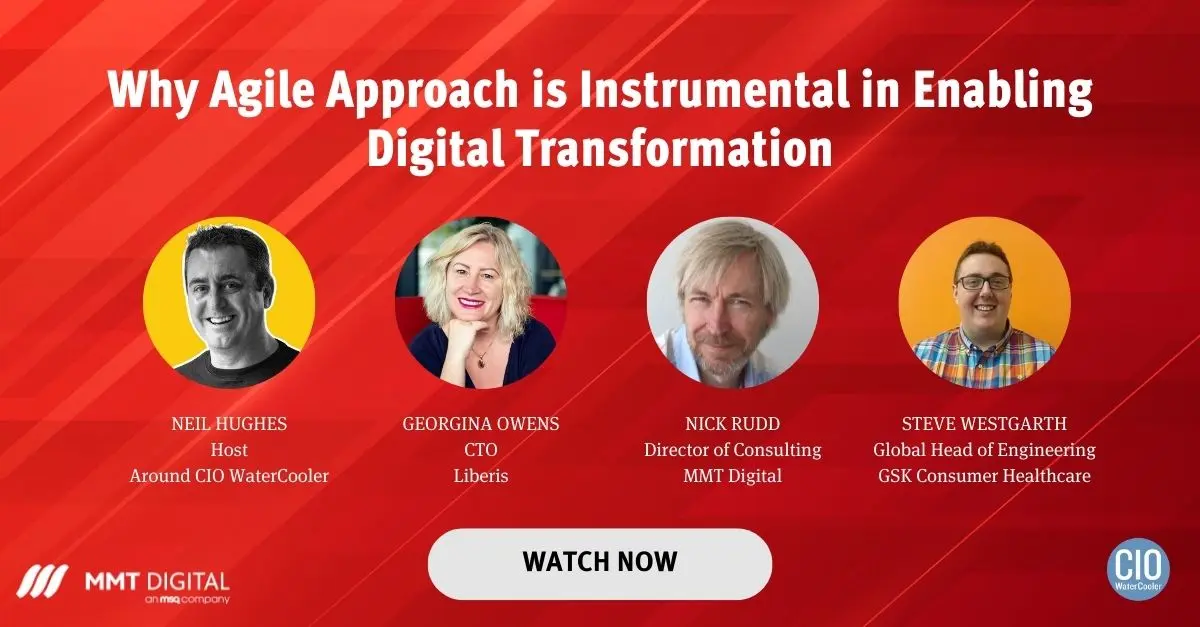No word defines conversations around digital transformations more than ‘agile’. But what agile means in practice and the value it can bring to your business isn’t always clear.
Our Director of Consulting, Nick Rudd, joined Steve Westgarth, Global Head of Engineering at Haleon and Georgina Owens, Chief Technology Officer at Liberis on the CIO Watercooler webinar to explore what agile business transformation is and how to get the most from one. Here we take a closer look at some of their insights.

WHY AGILE IS THE WAY FORWARD
Before we dive into some of the challenges of agile web development and how to implement it effectively, it’s worth defining agile and its benefits.
At its heart, says Nick, agile enables your business to “design the right product and then iterating towards the best outcome, so that you deliver value to customers in the real world. Importantly it also enables you to change as the business needs change.”
On the other hand, working outside an agile framework in a more traditional linear design-build-deliver process risks delivering a product that is no longer relevant.
As Steve explains: “in a landscape where customer trends are changing quickly, businesses are saying we need to respond to those customer demands in the right way in a timely fashion. When a business talks about being agile, what they really mean is being responsive to customers’ needs.”
Alongside developing a product that is right for your market, working in an agile way provides a framework in which businesses can invest smaller amounts incrementally and quickly see the value this investment creates. While they do this, they are building data with each release that informs the next.
FINDING THE RIGHT AGILE PATH FOR YOUR BUSINESS
However, for many organisations, an agile business transformation is a profound change and not always a comfortable one. At the core of agile is flexibility, but businesses understandably value certainty around issues such as timelines and revenues.
“That means they want dates when things are going to be delivered. In particular when you're selling a product to a partner they want to know when they’ll receive it, and have a very defined process,” says Georgina. But the pressure to deliver to set timescales and targets is often counterproductive. “Businesses shouldn’t be afraid to constantly reassess and change direction,” she says.
Overcoming a reticence to do this requires a shift of mindset. “All of these things aren’t unreasonable,” says Steve. “But we need to coalesce around the idea that we’re delivering customer value and working on problems that we have the information to solve, so we aren’t wasting time producing arbitrary estimates for things.”
The argument that incremental change delivers better services faster, compared to long-term projects with deadlines that are invariably missed, should be a convincing one for C-suite executives. They should also be reassured by the fact planning is a key part of the agile process.
PLANNING WITH PURPOSE
There is often a misconception that agile means “you are going to build things very quickly but not think too much about what you are building”, says Georgina. But in reality, understanding the purpose of your digital transformation is the critical starting point for agile web development.
“One of the key things we advise people to do is make sure you've got clarity from the start,” advises Nick. “That could be a business vision or a product vision, and those should align. If you can't tie your product vision back to your business vision, then you’ll probably build the wrong product.”
And building the wrong product is perhaps the costliest mistake a business can make. “Don't start with somebody saying, I need this widget built because it'll be cool or is going to change the world. You need to know how it’s going to align back to the north star that you set at the beginning of the product build. You can end up in a very bad place if you don’t.”
Interrogating why you are embarking on a new initiative will ensure you do not set off down the wrong road. Steve points to a recent project he worked on as an example. “Our leadership said we were going to build an iPhone app in Italy. After two or three months of planning, somebody did some research and found 80% of people in Italy use Android.”
It was an assumption about the market that could have been costly had it not been challenged.
FLEXIBILITY WITHIN AN AGILE FRAMEWORK
This ability to shift direction is one of the advantages of agile web development. It brings together a clear purpose with data points that are continuously updated during the iterative process, giving your business the knowledge to respond nimbly to an evolving market.
“It's about using the framework, but not becoming the framework. About making sure that you're actually operationalising something which works in your own context. Never lose sight of the focus on what you're trying to deliver, and that’s the focus on your customer,” says Steve.
Nick agrees: “Don’t start until you can start well – make sure you've got clarity about what you want to achieve and be ready to adapt. If you build like that you build predictability, and the business will love you. And your customers will love you because they know when they get something new, it’s going to be right.”
That clarity of purpose is something your organisation can build a culture around that empowers teams to make the right decisions, adapt quickly and challenge the direction of a project. That’s why agile is more than a buzzword, it’s a way to ensure your business stays ahead of the competition. For all Georgina, Steve and Nick’s insights watch the full panel discussion here.
And if you want to implement an agile business transformation that delivers real value, get in touch to find out how we can help.









